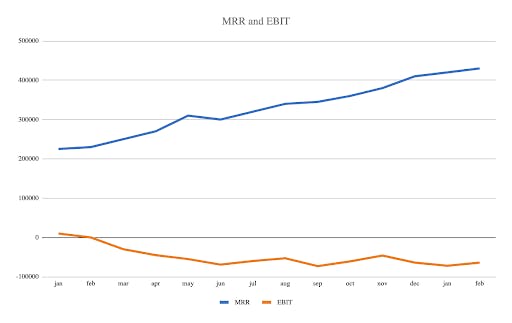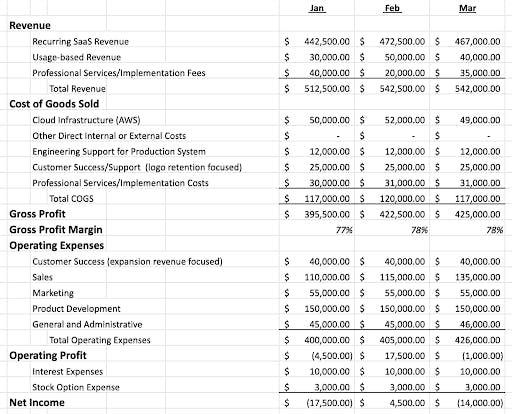Demonstrating the commercial viability of your SaaS business is crucial when pitching to venture capital investors.
It’s an important part of the due diligence process , and includes providing the investors with a financial model and showing them that you understand it.
In this article, we explain the key SaaS metrics to track and include in your financial model along with how to calculate them, and what exactly to include in your profit and loss (P&L) sheet.
So, let’s dive straight in!
The importance of storytelling
As a business seeking venture capital funding, your ability to clearly communicate your financials and key metrics is one of the key factors in convincing investors to fund you.
But just showing them page after page of numbers won't always cut it.
Instead, you need to grab and hold their attention from the beginning of your pitch. One way to do this is by weaving your metrics into a compelling story.
We spoke to VC investors and a leading SaaS advisor, who suggested placing a revenue trajectory slide near the beginning of your presentation, perhaps after the team members.
This slide should contain a clear diagram showing momentum, growth rate, and the size of the business over time. Here’s an example:

You can also annotate the trajectory diagram to show the effects of different significant events – such as the pandemic, or getting a new VP of sales – on your overall revenue.
The end result is to encapsulate the growth of your business into a compelling story, rather than all those numbers.
Key SaaS metrics and how to calculate them
Monthly Recurring Revenue (MRR)
MRR refers to the amount of revenue your company expects to generate every month, based on the value of your existing user subscriptions. MRR is important because it pays your bills every month – essential for maintaining smooth day-to-day operations. Investors want to be sure your company can survive – and MRR plays a key role in deciding that. You can calculate MRR by adding up the monthly fee of every user.
Annual Contract Value (ACV)
If your company has long (e.g. a year or more) contracts, then it's worth reporting your SaaS bookings (annual contract value (ACV)) data alongside your MRR. This creates another easy-to-understand snapshot of your business’s traction – perfect for your potential investors. Here’s the standard formula to calculate ACV:
ACV = Total contract value ÷ Number of years
Net Revenue Retention (NRR)
NRR is another key SaaS metric, and one which investors are increasingly focused on. The industry standard approach is known as the static pool method. Here, you examine your customer base from a year ago, comparing their MRR from then with their MRR now. That leads to your net revenue retention rate – a critical number for investors.
Gross Revenue Retention
Other potential funders, such as private equity investors, may also want to know your gross revenue retention rate. The gross figure gives a clearer picture of your customers’ actual churn, which the net figure may not reveal, especially if your business has experienced significant organic growth. Gross revenue retention rate allows potential investors to strip away other forms of growth and focus on the underlying retention.
CAC Payback Ratio
Customer acquisition cost (CAC) payback ratio is one of the most useful sales efficiency metrics to include in your pitch. Investors like it because it's intuitive. They know that if they invest a certain sum in sales and marketing, it will take X number of months before that money gets paid back for each new user that signs up.
What to include in your P&L sheet
The profit and loss (P&L) sheet is another central part of your pitch deck. But what exactly should you include in it?
Well, good news – there’s a standard P&L format that investors are used to seeing. It's best to stick with the standard, so investors don't have to put in any extra mental effort to understand your numbers. Using the standard format also helps investors to easily benchmark you against other SaaS businesses.
Check out an example from SaaS Capital below.

Notion Capital recommends adding extra granularity to the Revenue section, incorporating separate lines for recurring revenue, usage-based revenue, and implementation fees, then summing these up into total revenue.
Breaking it down like this allows you to more clearly align your cost of goods sold (COGS) with different revenue line items. It also allows investors to dissect your business a little more and understand the financial drivers.
Next, a quick look at COGS. Here, it’s important to stay consistent with what other SaaS businesses are doing.
In particular, our experts recommend breaking the customer success line into two separate line items:
1) customer success/support for logo retention
2) customer success for expanding revenue.
The first type of customer success (logo retention) supports the recurring revenue in the previous section, making it a COGS item.
On the other hand, customer success activities more focused on cross-selling and upselling (which are actually sales activities) should be placed below the line, either as part of the sales or marketing lines or on their own line altogether.
The potential dealbreaker: revenue recognition
Revenue – both amount and momentum – is critical because it drives the investment process and valuation. That's why investors will devote most of their due diligence process to unpicking it.
Because revenue is so important, there are several factors that can trip you up. For starters, your revenue numbers must be 100% accurate.
For example, many investors will find it unacceptable if your MRR sheet doesn't match up with your financials, even if that's just because you decided to do things differently. It's absolutely crucial to have your net revenue nailed.
Here’s a real-life example to illustrate why investors are so watchful about revenue. Around 10 years ago, HP acquired the UK-based software company Autonomy for $11 billion. Just a year later, they had to write off $8.8 billion of revenue because HP didn't recognize Autonomy’s revenue recognition practices. They’re still in court to this day.
Getting started
As an early-stage founder pitching for the first time, the financial models and metrics are critical to get right. But don’t let that intimidate you. There are tried and tested routes to follow, which will help you stay on track.
Keen to get started?




